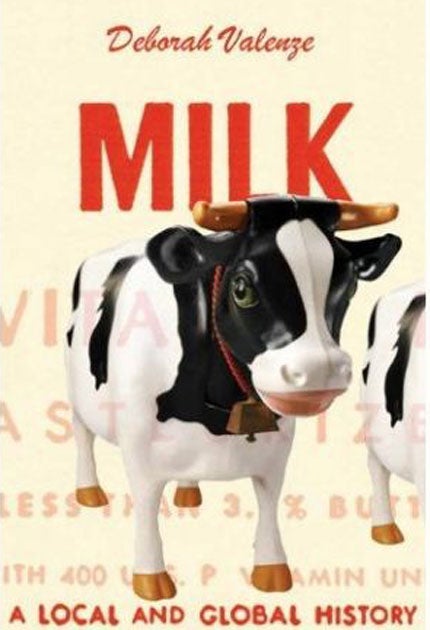Milk: a local and global history, By Deborah Valenze
A study made of the white stuff

Your support helps us to tell the story
From reproductive rights to climate change to Big Tech, The Independent is on the ground when the story is developing. Whether it's investigating the financials of Elon Musk's pro-Trump PAC or producing our latest documentary, 'The A Word', which shines a light on the American women fighting for reproductive rights, we know how important it is to parse out the facts from the messaging.
At such a critical moment in US history, we need reporters on the ground. Your donation allows us to keep sending journalists to speak to both sides of the story.
The Independent is trusted by Americans across the entire political spectrum. And unlike many other quality news outlets, we choose not to lock Americans out of our reporting and analysis with paywalls. We believe quality journalism should be available to everyone, paid for by those who can afford it.
Your support makes all the difference.Blessed are the cheesemakers." Not far into Deborah Valenze's 3,000-year history, it is apparent that instinct long anticipated wisdom. The Ancients' appreciation of milk was, around the time of the Great War, dignified with, or reduced to, the term "vitamin A". Governments urged its merits, but all educational drives pall beside the case of Bernard of Clairvaux.
The Life of Brian gag was more astute than Monty Python realised. In the 12th century, the Virgin Mary came to Bernard, unveiling a breast and squeezing three drops of milk into his mouth. This became a familiar image, spectacularly so in Alonso Cano's painting, where she directs it from some distance. As Valenze observes of this "miraculous arc of milk", its "startling literalness evokes amusement from modern viewers, separated as we are by several hundred years from the unmediated physicality of the Middle Ages. Yet the legend and its image speak volumes about the powerful hold of sacred milk on the western European imagination".
Valenze is attuned to all the eras that she traverses, back to that of Isis in Egypt, "a stately seated figure, her breasts exposed". Though her husband Osiris also possessed a vital organ, Isis outlived him, making copies of his phallus "which she then distributed for use in worship".
Adept in theology, history, sociology and more, Valenze delights in cheese. Whether deliberating upon biology or the fact that gustatory preferences brought cows rather than goats upon our fields, she is equally incisive at summarising such calamities as the use of spent distillery grain for animal feed in 19th-century New York.
Industrialisation and malnourishment form a substantial section of the book, from which Elmer McCollum emerges a hero. Born in 1879 to Tennessee farmers, he grew up in poverty alleviated by poetry and was saved from scurvy by strawberries (vitamin C). At university, he eked out income by lab work, after instinct had told him a cow's eating was crucial to its udders. What was more, he appreciated the Wisconsin dictum "speak to a cow as you would to a lady". In 1912, after feeding rats with fats, he hit upon vitamin A (the word being a conflation of "vita" and "amine").
The tragedy is that, a century on, many now speak to a cow as they would a robot, filling supermarket shelves with products which would do Bernard of Clairvaux no good at all.
Join our commenting forum
Join thought-provoking conversations, follow other Independent readers and see their replies
Comments